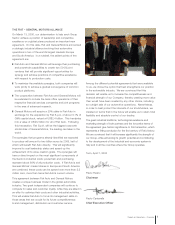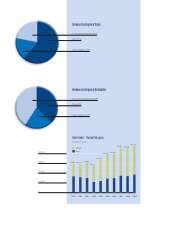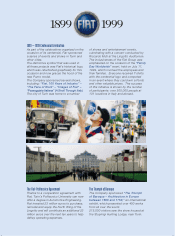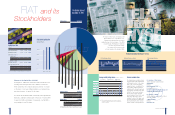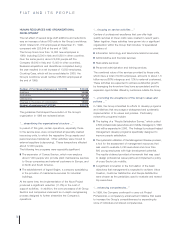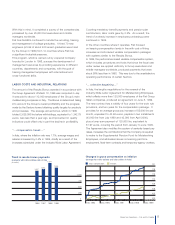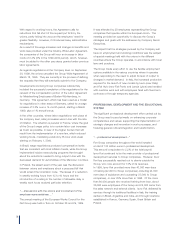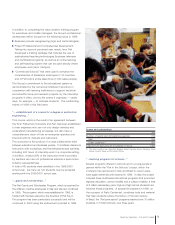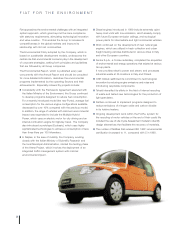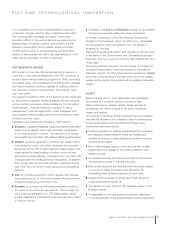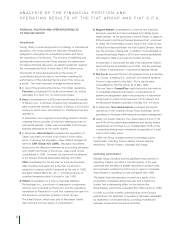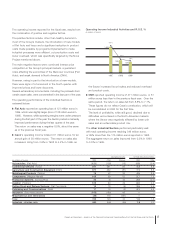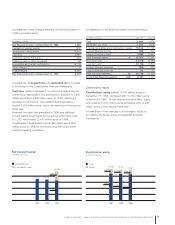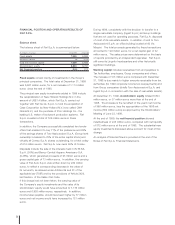Chrysler 1999 Annual Report Download - page 21
Download and view the complete annual report
Please find page 21 of the 1999 Chrysler annual report below. You can navigate through the pages in the report by either clicking on the pages listed below, or by using the keyword search tool below to find specific information within the annual report.
20
FIAT FOR THE ENVIRONMENT
Fiat approaches the environmental challenges with an integrated
system approach, which goes beyond the mere compliance
with statutory requirements, stimulating technological innovation
and value creation. This enables the Group to increase its
competitiveness in the global markets and improve its
relationship with its host communities.
The Environmental Policy adopted by the Company, which is
based on sustainable development models, underscores the
central role that environmental concerns play in the development
of corporate strategies, setting forth principles and guidelines
that are followed by all Group companies.
The Environmental Report, which is published every year
concurrently with the Annual Report and should be consulted
for more detailed information, describes the environmental
programs implemented by the operating Sectors and their
achievements. Especially noteworthy projects include:
❚Consistently with the Framework Agreement executed with
the Italian Ministry of the Environment, the Group continued
to develop programs designed to reduce fuel consumption.
For a recently introduced model (the new Punto), average fuel
consumption for the various engine configurations available
decreased by over 10% compared with the previous model.
In addition, the range of vehicles with minimum environmental
impact was expanded to include the Multipla Hybrid
Power, which uses an electric motor for city driving and an
internal-combustion engine for highway travel. The Company
also introduced a prototype (Ecobasic), which uses highly
sophisticated technologies to achieve a consumption of less
than three liters per 100 kilometers.
❚In Naples, in the area of mobility, the Company, working
closely with the Italian Ministry of Scientific Research and
the local Municipal Administration, started the testing phase
of the Atena Project, which involves the deployment of an
integrated traffic management system with minimal
environmental impact.
❚Diesel engines introduced in 1999 include extremely quiet
heavy-load units with low emissions, which already comply
with future European emission ceilings, and ecological
power plants for intermediate and light commercial vehicles.
❚Work continued on the development of new natural gas
engines, which are utilized in trash collection and urban
freight-hauling vehicles distributed in various cities in Italy
and other European countries.
❚Fenice S.p.A., a Comau subsidiary, completed the acquisition
of environmental and energy operations that existed at various
Group plants.
It now provides electric power and steam, and processes
industrial waste at 35 locations in Italy and Poland.
❚CNH Global reaffirmed its commitment to technological
innovation by reducing engine emissions and noise and
introducing recyclable components.
❚Teksid intensified its efforts in the field of internal recycling
of waste and tested new technologies for the production of
light granulates.
❚FiatAvio continued to implement programs designed to
reduce emissions of nitrogen oxide and carbon dioxide
in its turbine heaters.
❚Ongoing development work within the F.A.Re. system for
the recycling of motor vehicles at the end of their useful life
included the use of Life Cycle Assessment models to identify
design alternatives that facilitate the recovery of materials.
❚The number of facilities that received ISO 14001 environmental
certification increased to 11, compared with 5 in 1998.


